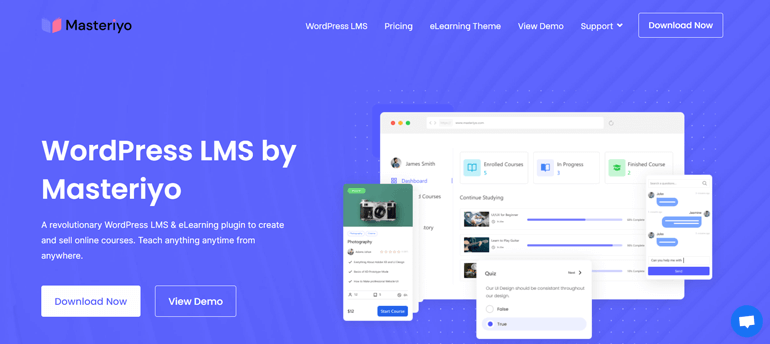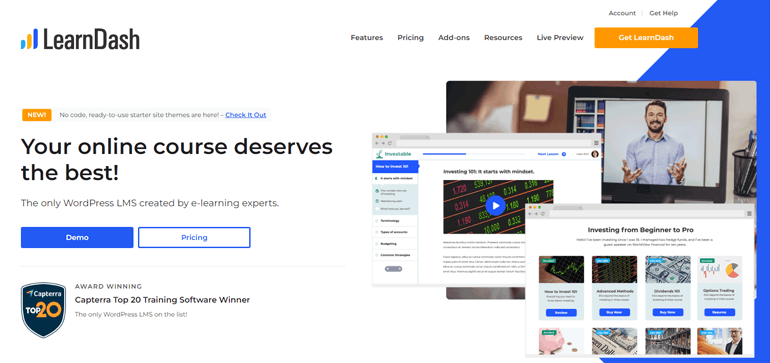Wondering what to look for while searching for a Learning Management System (LMS)? Do you want to know the must-have learning management system features? If so, this article solves your queries as it lists must-have learning management system features.
To get the right tool for your website, you should always be aware of the top-most features it should possess. And the same goes with the LMS for any site; because what makes an LMS top-notch is its features.
So, to make your job easier in picking the right LMS, we present you with the 15-must-have learning management system features. Before we jump onto the list, let’s briefly introduce LMS and why you need it.
What is a Learning Management System, and Why Do You Need It?
Learning Management System, also called LMS, is software that lets you create an online learning platform through the web. Most commonly, educational institutions and businesses use it to provide education and training courses online.
LMS systems enable you to provide education at a minimal or no cost, deliver audio and video content worldwide, and take online assessments through quizzes. After the pandemic, various institutions, organizations, and academia adopted the LMS to offer an online learning platform. As a result, the craze for LMS increased significantly.
What’s more interesting is that one can also make money by selling online courses through LMS. LMS is not only for academic institutions, but it’s also valuable for professionals who have expertise in a niche and want to earn by teaching online.
For example, if you have photography skills, you can create an online course website, sell courses, and make money online.
To make an LMS site, it’s easy with WordPress; install an LMS plugin like Masteriyo or LearnDash, and then you can add courses accordingly. To find out the entire process, check our full guide on creating an LMS website.
With that said, let’s check the must-have learning management system features that you should look for.
15 Must-Have Learning Management System Features to Look For
1. Simple and Beginner-friendly User Interface
Whenever you’re getting into some new tools and technology, the first thing you should consider is its user interface. And for those making LMS sites, the user interface is vital because you’ll be creating, modifying, adding, and doing many other things for generating online courses on the same site.
If the LMS you choose is not simple and beginner-friendly, and if you’re not a technology expert, you’ll definitely require a tech-savvy person to help you with most of the tasks. Therefore, a simple and beginner-friendly user interface for an LMS is a must-have feature to make the admin’s work less challenging and the tool more adaptive.

Masteriyo LMS is a great example of a simple and beginner-friendly user interface. It’s a free WordPress LMS plugin with which you can easily make a powerful LMS site.
2. Customizable
Another important feature that LMS must-have is it should be customizable in most aspects, from changing the logo to creating a customized certificate. This means that you should be able to design every page of the course according to your needs.
Similarly, an LMS can open the door to endless layout configuration for your site when it’s customizable. The feature is beneficial to both beginners and experts because you can customize the simple widgets to the CSS code of your website.
Thus, when an LMS is customizable, you get the full power of modifying the content over your LMS site.
3. Interactive Learning Platform for Learners
To make your learners more focused and enjoy your content, you should choose an interactive learning management system. An interactive LMS is the one that supports pictures, animation, video, captions, quizzes, social sharing, and more.
You must have heard the quote, “A picture speaks louder than words.” This implies more while learning because learners get a clearer concept and enjoy reading when there is a pictorial or video representation. Further, an interactive platform also lures the learners to come back often to learn more courses from your site.
4. Multi-content Support
These days, an online learning platform is never monotonous; instead, they conduct different webinars and video conferences, provide infographics, quizzes, and so on. So, for your site to stand out among hundreds of others, you should choose an LMS that supports multi-content.
Multi-content support in any course can also help you deliver an engaging learning experience to the learners. It lets you add varieties of personalized content, including audio, videos, podcasts, and so on.
5. Assessment and Evaluation Tools
What’s the use of LMS if it doesn’t have assessment and evaluation tools like quizzes, exams, and assignments? These are crucial to let one come out with at least a little knowledge after attending the course. Also, online learning doesn’t make it feasible to supervise the learners. So, to have a quality LMS site, assessment and evaluation tools are a must.
These tools also help you to obtain various information about your course. For example, Masteriyo lets you add unlimited quizzes at the end of each chapter. Also, you can create certificates to inspire learners to participate and do well.
Based on the grade obtained by learners, you can identify if your course was easy, difficult, required modification, and so on. You can also set the criteria for joining the other course for the learners based on their grades obtained from the previous course.
6. E-commerce Support
You may or may not be creating an LMS site to earn money. But in both cases, you must opt for the LMS that supports e-commerce. All the transaction processes are easy when LMS has e-commerce support.
Even if you had no intention of earning money by selling online courses, you change your mind later, and if your LMS doesn’t support e-commerce, you might get into trouble. At that time, you’ll be in a dilemma to either switch to a new LMS or stick with the old without earning money.

WordPress LMS plugins such as LearnPress, Masteriyo, and LearnDash seamlessly support e-commerce.
7. Automation
Technology has made many tasks easier and automated, and why not have an LMS with automation? Automation features for LMS can help you in reducing half of your tasks. It can lead to an organized and well-structured platform when the LMS you use has automation on various tasks.
Likewise, it can help you enroll learners, send notifications and reminders to learners about the deadline for a course or assignments, and even create a certificate on completion of the course. Therefore, automation is one of the learning management system features that you should always look for.
8. Surveys
When you create an LMS site to provide some knowledge or skill to the users, you obviously want to know the user’s view for further improvement in the course. And on doing so, a good survey tool can be quite helpful.
Therefore, the LMS with a survey function will make you capable of capturing important feedback about the course, its materials, or even instructors. You can further break down the report obtained from the survey to find the specific answers or analyze the learner’s feedback.
9. Personalized Learning
Personalized learning is the way of providing or recommending the content as per the individual interest. If your learning management system features personalized learning, learners can benefit the most because they get what they want. Using this feature lets one get more focused and on the track and brush up on the skill they’re interested in.
Based on the assessment data of an individual, LMS should be able to recommend the other possible path that the learners could follow. Meanwhile, in the absence of personalized learning, learners might get lost due to the overwhelming content and never return to your site.
10. Data Analytics and Reporting
Since data is everything that one might require to find out the potential information, data analytics and reporting are one of the most valuable features of the LMS. A good LMS should showcase the learners’ data with their progress report, marks obtained, completed courses, and all other data related to learners and the course.
As an admin, it helps you improve your ability to provide qualitative knowledge because the report provides an insight into what learners want. Additionally, you can use the report to analyze which content of your site is learned most by the learners, which has the least views, know if your target audience has taken the course, and many more.
11. Integration with Other Platforms
An LMS must have seamless integration with other platforms. Because as an admin, you might be using different CRM tools, webinar tools, or automation tools for your regular tasks. This helps an admin add other functionalities on the website that might be important but not available on the LMS.
At the same time, such integration will also be beneficial when you want to earn money by selling an online course because you can integrate the different payment gateways as well. All the necessary integration, including database and speed optimization tools, should be available in an LMS.

LearnDash is the best example of an LMS that supports multiple integrations like PayPal, BuddyPress, Slack, Mailchimp, and many more. All these apps are essential for running a website successfully.
12. Gamification Tools
Gamification tools in the LMS are the presence of some competitive strategy to finish the course. When you add some spice to the learning by adding a gamification element like points, badges, leaderboards, and more, learners tend to engage more seriously and complete the course on time. It also works as a motivation for the learners.
For example, suppose you create a leaderboard to complete a certain portion of the course for each week. In that case, it results in a healthy competitive learning process among the learners and makes them excited about the course each passing week.
Thus, look for the gamification tools on the learning management system features, before you choose the one for creating an online course.
13. Social Learning
Social learning in an LMS must-have features that let a learner share and interact about the subject matter with other learners or instructors. Those interactions or knowledge sharing are stored on the same LMS for future reference.
So, an LMS should support social learning to let learners share their experiences, views, confusion, and the knowledge obtained from the online course. When an LMS has a social sharing feature, you can effortlessly provide discussion forums, chat systems, and online communities for learners to interact with the instructors and their peers.
It can also highly influence active knowledge sharing with guidance and support. Overall, a collaborative environment where one can learn from others’ experiences is developed through an LMS supporting social learning.
14. Security
In the era where data privacy has become a major concern for the people using the internet and its material, security has been the most looked at feature for every website, including an LMS site. Being an admin, you should be responsible for the security of your learners. So, choosing an LMS which prioritizes security is the solution.
Hence, always look for an LMS that follows advanced safety protocols and meets the industry’s standards. Some third-party certifications that identify the software as secured are General Data Protection Regulation (GDPR) compliance, Service Organization Control (SOC) 2 certification, or ISO 27001.
15. Responsive Design
Due to the increasing number of people using smart devices like phones, laptops, desktops, tablets, and more, the audience to your LMS site might also try to access your content through varieties of devices. In such a case, a responsive design for your site is a must to make your content accessible through multiple devices.
The responsive design can provide a flexible learning experience for learners, while its absence may lead to frustration on the site. Thus, whether your learners are sitting on a couch with their laptop or traveling on a bus with a smartphone, they should be provided with a responsive LMS site to complete their course from any device without any hassle.
Wrapping It Up!
We hope that you’re now clear about the LMS must-have features. If you can choose the one with all of the above features, you’ll no longer have to switch the LMS with its other alternatives.
Besides the above-mentioned learning management system features, the other features also depend on the type of learning platform that you want to create.
If you want to land safely, you can choose Masteriyo LMS as one of the best learning management systems. It covers most of the important features that an LMS must-have. Give it a try and comment below on how you feel about the plugin.
We want to thank you for sticking with us until the end of the article. If you still have some time, you can also check out other articles from us: LearnDash vs Teachable, LifterLMS vs LearnDash, LearnPress vs LearnDash, and many others.
Also, you can follow us on Twitter and Facebook to get notified of every new article.
